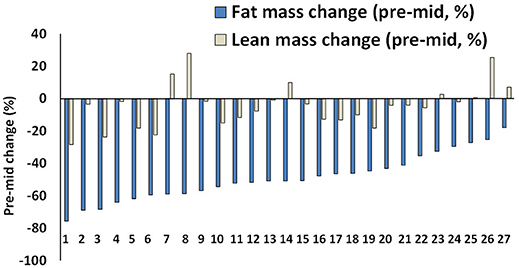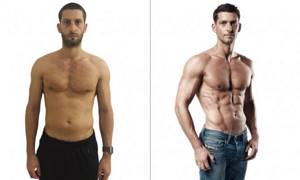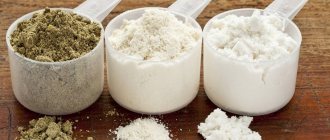Creating an Optimal Calorie Surplus
Although your initial goal is to gain muscle mass, you need to keep two goals in mind when creating an optimal calorie surplus:
- Muscle gain
- Reduction of body fat
In this regard, there are 2 main factors that determine the optimal calorie surplus:
- The caloric surplus must be significant to increase muscle mass;
- The caloric surplus should be small to reduce body fat.
As you can see, there are some limitations to the amount of muscle mass that the human body can create. This means that there are also certain limits on the number of calories your body can take in.
If you consume more calories than your body needs, they will be stored in body fat rather than muscle.
For this reason, you need to avoid large calorie surpluses.
At the same time, if the calorie surplus is insufficient, muscle will not be formed at all, or will grow incredibly slowly.
This means that you need to be very clear about your caloric surplus. Below are my recommendations that will work for most people...
Calorie deficit with low fat percentage
If you are in a calorie deficit and at the same time have a low percentage of fat (for men, for example, it is less than 7-10%, here is more information on how to measure the percentage of body fat), then you will most likely lose muscle mass. For women, the critical percentage of body fat is much higher.
There is a study in which women, in preparation for bodybuilding competitions, still lost not only fat, but also muscle, in a calorie deficit. This is due not only to high training, but also to the achievement of a very low percentage of fat for women - athletes reached 12% and below.
By comparison, girls with anorexia have an average body fat percentage of 9-13% (Mayo-Smith, 1989; Mayer et al., 2005).
Some experts draw a parallel: 12% body fat in women is roughly equivalent to 4% body fat in men.
Separately, it should be said that an extremely low percentage of fat is extremely harmful to health, but this is a separate topic.
This graph shows how fat mass (blue bars) and muscle mass (beige bars) changed in 27 female athletes as they prepared for a bodybuilding competition.

Source: study by Hulmi et al., 2021.
As can be seen from the graph, all the girls, being on a calorie deficit, noticeably reduced their fat reserves, but only 7 out of 27 managed to increase muscle mass.
How many calories should you consume daily to gain muscle mass?
- Optimal calorie surplus for MEN: 250 calories per day.
- Optimal calorie surplus for WOMEN: 125 calories per day.
Let's take a closer look...
- Men: 250 extra calories per day For example, if you are a man with a maintenance calorie level of 2000, you should consume 2250 calories daily to gain muscle mass. Regardless of your maintenance level, you need to add 250 calories daily.
- Women: 125 extra calories per day For example, if you are a girl with a maintenance calorie level of 2000, then you need to consume 2125 calories daily to grow muscle mass. At any maintenance calorie level, you need to add 125 calories.
Determine your maintenance calorie level and calculate how much of a calorie surplus you need to create. Have you already done this? Great. This is exactly the amount of calories you need to consume daily!
Make sure you write down this number.
The additional calories you consume above this amount will only add additional weight, less calories will not give you positive results.
Therefore, this number represents a caloric surplus that will help you achieve muscle growth most quickly and effectively and minimize the possibility of gaining excess weight.
Of course, the main reason for creating a calorie surplus is uniform weight gain .
You ask, is there a norm for increasing muscle mass?
Here she is…
Choosing the right calorie intake to gain lean muscle mass without fat
In this article we will tell you how to eat right to increase lean muscle mass without excess fat and how to overcome a plateau in muscle growth. We will determine what the correct daily caloric intake should be for active muscle growth without increasing body fat.
What you need to know...
- At some point, all bodybuilders slow down their muscle growth process. And increased nutrition is not the best way to restore it.
- The body is not able to build more than a couple of kilograms of muscle in a month. So don’t think that the excess food you eat will be processed so easily and won’t be deposited anywhere.
- There is a much better way to accelerate muscle growth without overeating. Moreover, during the period of increased nutrition while building muscle, you should not eat useless food.

Games with gluttony
To develop bulky muscles, you need to consume enough proteins, fats, carbohydrates and vitamins. One cannot but agree with this. If you like to work with heavy weights and do not accept protein shakes and other liquid nutritional supplements, then without eating enough of the right foods you will not build sculpted muscles.
If you don't consume enough nutrients, your body will be in an unsuitable state for building muscle. That is, if you don’t eat enough, then even with training you will not gain, but rather lose muscle.
So, the answer seems to be on the surface: eat more, grow more, right?
Not so fast!
If you don't consume enough, muscle growth will automatically stop. But this does not mean at all that the more you eat, the more developed your muscles will be.
This is one of the biggest mistakes on the way to an aesthetic appearance and stable muscle physiology. Eating too much junk only stimulates the growth of body fat, not muscle growth.
If you are an ordinary athlete, then your body, like the body of any person, has a certain limit for muscle growth. The amount of muscle you can build depends on your body's power and its ability to synthesize enough protein to build new muscle fibers.
This body power depends on your natural testosterone levels, testosterone-to-cortisol ratio, insulin sensitivity, muscle fiber health, and your genetics.
You can eat as much as you want. But you won’t be able to influence the restrictions nature gives you on protein processing. Overeating will cause more and more fat deposits to appear.
Your body is a builder

Imagine that your muscles are a house under construction. The bricks from which a house is built are amino acids (obtained during the digestion of protein), while the money you pay builders for successful work is the carbohydrates and fats consumed.
And finally, the workers represent factors that directly affect the process of protein synthesis (mainly testosterone), and the truck that supplies the workers with bricks is insulin, which plays a major role in transporting nutrients to the muscles.
If you don't provide the workers with enough bricks (that is, protein), they won't be able to build the house as quickly as you want. That is, in this regard, protein deficiency will slow down the muscle growth process.
If you don't provide your employees with proper, general nutrition, they won't have any strength or motivation to work at all. As a result, the house is again being built too slowly. And if you also cut the wages of your employees, they will begin to get angry, organize strikes and, in particularly extreme cases, start demolishing a building that is still under construction (this is comparable to the process of catabolism, with a too low-calorie diet).
So, a deficiency of protein and calories will have a detrimental effect on the muscle growth process and will lead to its serious slowdown.
What will happen if you start sending more bricks to your “construction site” (that is, increase your protein intake)? Naturally, the house will begin to be built faster, because there will no longer be a shortage of raw materials.
But by continuing to supply more and more bricks, at some point you will slow down the construction process. Workers are limited in their abilities and can only do a certain amount of work per day - they simply do not have the strength to do more. For example, if your construction crew is able to lay 1,000 bricks per day, then 2,000 bricks will not improve this figure at all. This amount only exceeds the working capacity of the workers. Therefore, unused bricks will go to waste and will not be used.
If you raise your workers' wages (that is, increase the number of calories they consume), chances are that their motivation will increase and construction will continue with renewed vigor.
Just as with bricks, a major increase in wages will do nothing to improve construction workers' results. No matter how much you pay them, they have their own physiological production limit - their strength will not increase indefinitely - the maximum speed of laying bricks cannot possibly increase - this is already innate physiology.
Muscle growth and weight gain
Under certain conditions - the right diet, training, nutritional supplements - a healthy male body is able to grow up to 300 grams of muscle per week. This is the amount that our innate physiology allows us.
So, in a month, if you follow all the rules, you can gain about a kilogram of muscle mass. At first, this doesn’t sound particularly impressive, but in a year you gain about 10 kilograms of muscle.
In the process of building muscle, it is very likely that you will manage to gain excess weight. However, you should not think that this is due to the growth of the fat layer. When you increase muscle size, you increase the available space for storing water and glycogen. More muscle means more glycogen.
A trained bodybuilder has about 40 grams of glycogen per 100 grams of muscle. So if you add 10 pounds of muscle, you also increase your muscle glycogen storage to 10 pounds.
Due to the increased volume of water and glycogen in your muscles, when you gain 10 pounds of muscle, your total weight will increase by about 6.3 pounds (assuming, of course, that this is not fat mass).
If you manage to gain more than 1.5 kg per month, this means that you may be increasing your fat mass.
A fine line

“But I gained 6.5 kilograms of muscle in three months, it can’t be fat!”
I hear this often. If you can’t gain more than a couple of kilos in a month, then what about those who managed to build up piles of muscle without increasing their fat layer?
This is exactly what I call a “fine line.”
There is a certain percentage of fat at which the body begins to look slim. For most men it's about 10%. And there is also that percentage at which the body begins to look fuller. This is around 18-20% for most men. Between these two indicators there is a zone in which your body looks like it is not changing at all.
During this period of time, even if you gain weight due to fat, there will be no visual difference. You are not yet slim enough to have a clear, defined silhouette.
This is aggravated by the fact that you see yourself in the mirror every day, which makes it impossible to notice any changes. The majority of men will not see the difference between 13-16% increased muscle mass.
But if you weigh more than 90 kilograms, then 13-16% muscle will easily provide you with 3 kilograms of fat!
That is, a healthy young man, having gained 3 kilograms of muscle mass, will easily earn about 6-7 kilograms of fat + 1 glycogen in three months. And he himself will firmly believe that he has gained 10 kilograms of strong muscles. After all, he considers the weight gained in general.
If such hard training in combination with regular overeating continues, then in the end you can easily gain up to 10 kilograms of excess fat in a month.
Increased nutrition and fasting: good or bad?
Traditionally, bodybuilding has two radically opposite approaches - increased nutrition and abrupt cessation of nutrition. This helps achieve the opposite effects.
With increased nutrition, body weight increases significantly, without disturbing the external aesthetics of the body. Many trainers even recommend force-feeding yourself. The main thing is not to engage in cardio training - this can slow down the process of weight gain.
Accordingly, if you suddenly stop eating, you can easily get rid of the hated fat mass. This requires serious physical activity, including cardio and strength training.
Well, now, the two main problems of such a radical, bilateral approach.
Problem #1: This approach takes away time that could be spent building muscle.
While losing fat, you will not be able to gain muscle mass. It's simply not possible for the typical bodybuilder to lose fat and gain muscle. During a sharp reduction in calories, muscle mass does not increase. In most cases, you will even lose muscle weight.
If you eat intensely for 6 months, and in the next three you sharply reduce the amount of calories you consume, then it is during these three months that muscles will not grow. If you don't overeat, you don't have to spend three months on low-calorie eating - you can spend it building muscle.
Problem #2: Hyperplasia of fat cells. You can increase volume either by increasing existing components (hypertrophy) or by adding new components (hyperplasia).
Fat cells (adipocytes) are like little sacs. The more fat you put in these pouches, the more fat they get. But these bags can only hold a certain amount of fat, and our body is a machine designed to store nutrients necessary for survival. Therefore, in difficult circumstances and with a large supply of nutrients, it may simply add new fat sacs to the existing ones.
When you overeat over a significant period of time, the body increases the number of fat cells. Although you can, of course, reduce the volume of fat cells by emptying them of fat, the fat cells themselves cannot be removed without surgery. Your body can create new fat cells, but it cannot remove them.
The more fat cells you have, the easier it is for your body to store fat. So, by adding new fat cells, you will actually only provoke it to further retain fat, which will be practically not burned, no matter how much you want it.
By overeating, you can stimulate adipocyte hyperplasia, which will make it more difficult to lose fat and even speed up fat gain and subsequent storage.
Simple math: which situation is better?
SITUATION "A"
- Focus on oversaturation;
- Earn 11.5 kilograms in 6 months;
- 2.5-4.5 kilograms of this weight will be muscles, and the rest (which is 7-8 kilograms) will be fat and glycogen;
- To get rid of excess fat you will have to go on a strict diet. And if you never deceive yourself and strictly follow all the rules, then you can get rid of a maximum of 1 kilogram of fat per week without losing muscle mass;
- It will take about 6-12 weeks to lose fat. And that's the best case scenario.
Plus, fat loss is not a linear process. The body adapts to caloric restriction and fat loss. In reality, getting rid of stored fat—unless you want to lose muscle—requires 12 to 20 weeks of strict dieting. The hunger strike will become more and more difficult.
In the period of 9 - 11 months you will gain about seven pounds of muscle ~ 3.2 kg (if you don't lose anything during the diet). This is an average of about 300 grams per month.
SITUATION "B"
- Increase the amount of calories, but exactly in the amount that your body requires to fully grow muscles;
- You gain about 700 grams of muscle per month without gaining excess fat;
- During the first six months, you increase in weight by 4.5 kilograms and only 1-2 kilograms of this is fat;
- To get rid of excess fat you will have to go on a diet for no more than a month.
In 7 months you earn about 3.5 kilograms of pure muscle. Over the course of a year, this is approximately 5.5 kilograms.
Remind me - why do you need enhanced nutrition at all?
If overeating is so bad, then why is it so often recommended?
- TRADITIONS
All bodybuilders since the 60s have gone through phases of “gluttony” and “hunger strike.” However, they did not gain much weight. This is only due to the fact that in those years there was not so much “junk” food.
Bodybuilders from the 60s based their diet on steak, whole milk and eggs. They ate tons, but all these products were incredibly healthy and simply “stuffed” with nutrients and microelements, not to mention vitamins. Modern bodybuilders do not neglect pizza, donuts and sweet pastries during the period of increased nutrition. In both cases, the volume of food is equally large, but the result of such nutrition is completely different.
- THIS IS USEFUL FOR WINNERS
Alternating between enhanced nutrition and a strict diet is a process characteristic only of bodybuilders. And especially stubborn bodybuilders, who often participate in competitions, for the most part want to look perfect only for one situation - during demonstration performances on stage.
The process of getting yourself into stable athletic shape requires a lot of sacrifice. Therefore, you can afford any culinary masterpieces only immediately after competitions and demonstration performances. This is an excellent reason to start eating more after long-term restrictions. But the average bodybuilder always wants to look good.
The average bodybuilder has no need to maintain a stable form (2-4% body fat). It is enough to be slim and have well-defined muscles.
- ONLY FOR “UNNATURAL” BODY BUILDERS
Competitive bodybuilders, skilled in the fast-eat approach, achieve victories with the help of performance-enhancing drugs and special medications. This is how they artificially increase their body chemistry. This is the only way to exceed your natural limit for muscle growth. Eating tons only works for these kinds of “advanced” athletes.
A true athlete is limited in the amount of nutrients he can use to build muscle mass. And this does not apply to bodybuilders taking chemical drugs. Anabolic substances such as steroids, insulin, IGF-1 can help bypass the body's biological boundaries given by nature.
Prohibited substances can speed up fat loss processes. Thyroid hormones, clenbuterol and growth hormone will cause the body to lose fat at a rapid rate. In addition, steroids prevent muscle loss during dieting. So no matter how much you cut your calorie intake, muscle mass is here to stay.
- RATIONALISM
Many people use overeating as an excuse to eat something harmful. Most people completely lack discipline in this process, but it is discipline that helps achieve a slender, aesthetically beautiful, defined silhouette.
For most bodybuilders, overeating is a reason to fill up on “junk” food. If self-discipline had been observed, they would have been able to achieve much more significant results.
The illusion of a muscular body

If someone has decent muscle mass, then when adding a layer of fat, such a person will look much more pumped up. True, this is only from the outside.
Muscle mass is a kind of foundation on which fat grows. Therefore, with a decent amount of muscle, the fat enveloping the muscles will visually increase their size.
Plus, there is also a certain state of fatness in which the gained fat creates the impression that it is the muscles that have grown.
When the percentage of body fat increases from 13% to 16%, the body will look the same - there will be no significant changes.
But if, with a weight of 100 kilograms, a bodybuilder gains 13% - 16% fat, it will increase to 104 kilograms. He will have the same amount of muscle and 4.5 kilograms more fat. But outwardly he will look larger and much more muscular than before.
If you are not skinny, adding fat will at some point make you look more muscular. People simply underestimate the amount of fat they carry around. As a result, over a long period of time, its volume can increase significantly.
My illusion of a muscular body
At 17 years old I weighed 81 kilograms. I had a waist of 81 cm and 13-14% body fat. I was a football player and somehow decided to increase my size and began to eat more. I was consuming about 10,000 calories a day (7,200 of which were from weight gain shakes). In six months I began to weigh 102 kilograms.
I thought it was all muscle. I was getting stronger and looked bigger in clothes. My mom told me I was getting fatter, but I thought she just wanted to discourage me from working out.
Unfortunately, my waist had grown to a meter, but I didn’t notice it myself, because my mother bought me pants at that time. They didn’t fit me tighter (after all, she bought pants in a larger size), and therefore, it seemed to me that I wasn’t getting fatter.
Then I somehow saw photos of myself where I was shirtless. And I was in shock. I was fat!
It took me a year to get back to my 80cm waist. My weight dropped to 87 kilograms. And I lost about 3.5 kilograms of muscle.
The illusion of a non-muscular body
Losing fat will make you look and feel smaller, with less muscle mass. But this is just the beginning. There's not that much of a visual difference between 13 and 16% body fat. Thus, after losing the first 3-7 kilograms of fat, you will not look more toned and defined.
The muscle definition will still be the same, but your clothes will hang and you will feel smaller because your muscles will be flat due to the lack of glycogen. This way, you will look and feel smaller without much definition.
Because of this phenomenon, I quit several diets. Four weeks of dieting makes you feel small and wimpy. So many people automatically return to increased nutrition.
But the diet won't help until you lose at least 10% of your body fat. After this, you will begin to look bigger, even if you become less and less in weight and volume (thanks to fat loss).
Only 8% of people believe in this theory. Others stuff themselves with food to gain weight and shape.
Examples of illusions
The first is Sebastien Cosset. Young bodybuilder. He weighed more in the photos before training than in the photos where he was in great shape. Despite this, in the latest photos he looks much larger and much more impressive.

The second example is Christianne Lamy, a female bodybuilder and sports nutrition specialist. In the photographs before the start of training, she weighs five kilograms more than in the photographs after training.

And finally, the last two samples. Allen Kress and Mike Hanley, who trained regularly and followed a strict diet. They demonstrate that when you increase volume through muscle mass, you will actually weigh less than before you started training. Before the start of training, they both weighed 10 kilograms more than after.
This is Alan:

And this is Mike:

So you need to eat like a bird?
No. To increase your body muscle, you need to consume more calories than you burn each day. The main thing is to choose the right daily calorie intake, which will allow you to grow muscles without increasing the percentage of body fat.
Read more about what to eat before training for muscle growth.
The following table shows the relationship between lean body mass (excluding fat mass) and caloric intake. For example, someone weighing 200 pounds with 12% body fat will have 84 pounds of muscle excluding fat.
Table: the optimal amount of calories consumed for stable muscle growth.
| Lean muscle mass (total body weight minus fat weight) | Calorie intake for optimal muscle growth |
| 55 kg | 2455 Kcal |
| 58 kg | 2634 Kcal |
| 63.5 kg | 2813 Kcal |
| 68 kg | 3037 Kcal |
| 72.5 kg | 3260 Kcal |
| 77.1 kg | 3440 Kcal |
| 81.6 kg | 3663 Kcal |
| 86.1 kg | 3885 Kcal |
| 90.7 kg | 4064 Kcal |
| 95.2 kg | 4244 Kcal |
| 99.7 kg | 4467 Kcal |
| 104 kg | 4646 Kcal |
| 108.8 kg | 4868 Kcal |
| 113.3 kg | 5091 Kcal |
| 117.9 kg | 5270 Kcal |
| 122.4 kg | 5494 Kcal |
This calorie consumption system will allow you to gain about 1.5-2 kilograms per month. If you are not gaining this amount, then you should gradually increase the amount of calories you consume until you reach the required growth rate.
If you increase your weight by more than 2 kilograms in a month, then most likely you are getting fat. It is necessary to reduce the amount of calories you eat.
The best way to achieve results

I'm tired of watching young people potentially destroy their bodies thanks to the advice of "experienced" internet gurus. They eat junk food and fatten up their skinny bodies.
The majority of novice athletes are undernourished, thinking that in this way they support muscle growth, but this, as we found out, is not the best option.
Remember, if your muscles are not growing fast enough, this does not mean that you need to stuff yourself with food (including unhealthy ones) to the fullest and swallow pills. And some more information on how to build muscle mass.
Original article: https://www.t-nation.com/training/truth-about-bulking
Norm of weight gain
You must understand that if you correctly determine your calorie surplus and eat the required amount of food daily, you will gain weight evenly.
The norm is the optimal value. If you exceed it, then you form fat deposits. If you do not reach the required value, then you are not gaining muscle mass.
What is the norm for gaining muscle mass?
Normal muscle mass gain for men and women
| Floor | Normal muscle mass gain |
| Men | 250 grams per week (1 kilogram per month) |
| Women | 125 grams per week (500 grams per month) |
Men should set a goal of gaining 250 grams per week (or 1 kilogram per month). Women looking to gain muscle mass should gain 125 grams per week (or 500 grams per month).
It's clear? Great. Now let's figure out how it works.
How can you tell if you're consuming the right amount of calories?
Let's go back a little. Now you know your optimal calorie surplus. You also know your maintenance level and the number of calories you need to consume to gain muscle mass.
You know what constitutes a uniform gain of muscle mass.
All that's left to do is make sure your calculations are correct and everything works .
All you need to do is start eating the required amount of calories daily, weigh yourself once a week (in the morning on an empty stomach) and monitor the results.
Depending on your results, which vary from week to week, you need to take the following measures:
- Are you gaining weight evenly? If so, then please accept my congratulations. Continue to eat the same amount of calories and make sure your workout is structured smartly and effectively (how to create an effective workout program). The best results await you!
- Are you losing weight or maintaining the same weight? If so, your caloric surplus is too low (or non-existent) and needs to be increased. Simply add 250 calories to your maintenance level (if you're currently eating 2,500 calories, take 2,750 calories) and then monitor your results over the next two weeks. Return to this step later and take appropriate action.
- Are you gaining weight too quickly? If so, then your caloric surplus is too large and needs to be reduced. Simply remove 250 calories from your diet (if you currently consume 2500 calories, take 2250 calories) and then monitor the changes. Depending on your results, follow the correct instructions.
In general, weigh yourself once a week in the morning on an empty stomach and keep a record.
If you gain weight evenly, then everything is ideal. If not, then add or subtract 250 calories from the amount you currently consume. It's simple.
What if I hit a plateau and stop gaining weight?
Depending on the amount of muscle mass desired, it is possible that some people may reach an extreme point where they can no longer develop any further.
If this happens (and continues for several weeks), guess what needs to be done? Yes that's right. Increase your calorie intake again by 250 (for men) and 125 (for girls) and monitor your weight gain.
And at the same time, the most important part of your nutrition program is completed!











